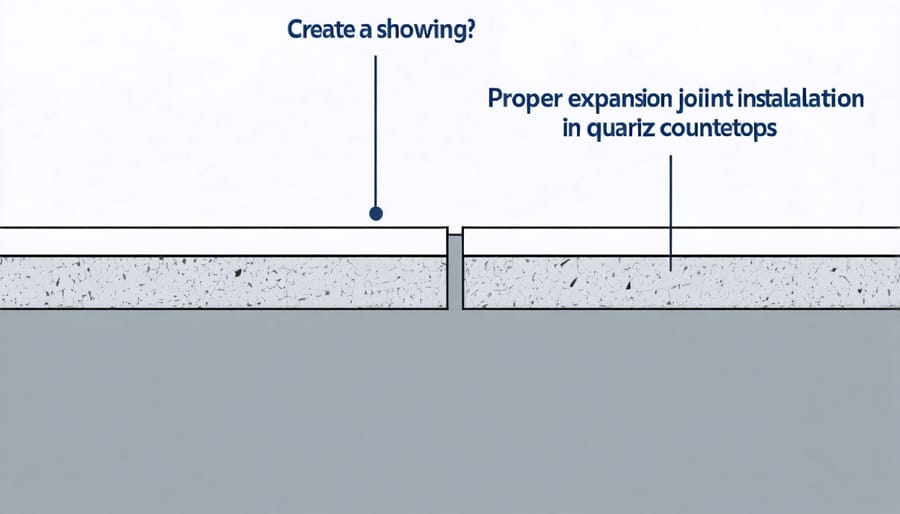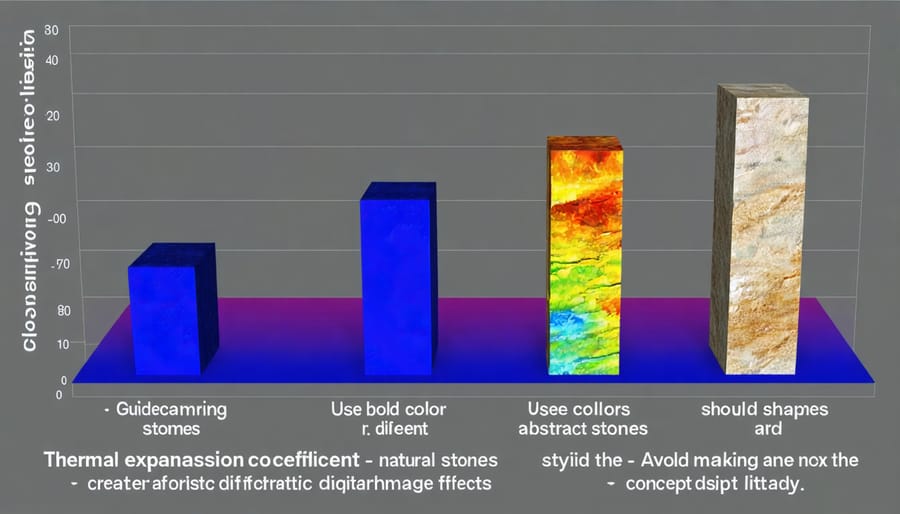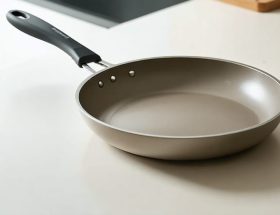Quartz’s remarkable thermal expansion properties make it one of nature’s most intriguing and valuable materials. Unlike most substances that expand significantly when heated, quartz exhibits exceptionally low thermal expansion, expanding only 0.000000587 inches per inch for each degree Fahrenheit increase in temperature. This unique characteristic has revolutionized industries from precision instrumentation to modern kitchen countertops. In aerospace applications, quartz components maintain their dimensional stability through extreme temperature fluctuations, while in everyday applications, quartz countertops resist cracking and warping even when exposed to hot cookware. Understanding quartz’s thermal behavior is crucial for architects, designers, and homeowners who need materials that combine aesthetic appeal with outstanding thermal stability. This extraordinary resistance to thermal expansion, coupled with quartz’s natural durability and beauty, explains its growing popularity in both technical and decorative applications.
The Science Behind Quartz Thermal Expansion
Understanding Thermal Expansion Coefficients
Thermal expansion in quartz is measured using a coefficient known as the Coefficient of Thermal Expansion (CTE), which quantifies how much the material expands or contracts with temperature changes. For natural quartz, this coefficient typically ranges between 13-16 × 10⁻⁶/°F, while engineered quartz products may vary slightly depending on their composition and manufacturing process.
Understanding these coefficients is crucial for proper installation and material selection. The measurement involves calculating the dimensional change per unit length for each degree of temperature change. This relates directly to the thermal mass properties of the material, affecting how it responds to temperature fluctuations in different environments.
For practical applications, professionals use these measurements to determine appropriate expansion joints and installation methods. A lower coefficient indicates more stable dimensional behavior under temperature changes, making quartz a reliable choice for various applications where thermal stability is essential. This predictable expansion rate helps prevent common issues like cracking or warping in installations exposed to significant temperature variations.

Temperature Range Effects
Quartz exhibits different expansion rates across varying temperature ranges, making this characteristic crucial for both design and installation considerations. At room temperature (20-25°C), quartz maintains relatively stable dimensions with minimal expansion. However, as temperatures rise, the expansion rate increases predictably but not uniformly across all ranges.
Between 0-100°C, quartz shows a modest linear expansion rate of approximately 0.5 x 10⁻⁶ per degree Celsius. This rate becomes more pronounced in the 100-200°C range, where the material can expand up to 1.2 x 10⁻⁶ per degree Celsius. Beyond 300°C, quartz undergoes a significant phase transformation, dramatically affecting its expansion properties.
In outdoor applications, where temperature fluctuations can be extreme, quartz surfaces may experience daily dimensional changes of up to 1/8 inch per 10 feet of material. Cold weather conditions below freezing cause minimal contraction, while high summer temperatures can lead to notable expansion, particularly in direct sunlight. Understanding these temperature-dependent behaviors is essential for proper installation planning and maintaining the integrity of quartz surfaces over time.
Practical Implications for Construction
Joint Requirements
Proper joint spacing is crucial when installing quartz surfaces to accommodate thermal expansion and prevent potential damage. For interior applications, expansion joints should be placed every 15 to 20 feet in both directions, with additional joints required where quartz meets different materials or changes direction. These joints typically need to be at least 1/8 inch wide, filled with a flexible silicone sealant that can compress and expand with the material.
In exterior applications, where temperature fluctuations are more extreme, expansion joints should be placed more frequently, typically every 8 to 12 feet. The width of these joints may need to be increased to 1/4 inch or more, depending on the expected temperature range and the size of the installation.
Special attention must be paid to areas around heat sources, such as fireplaces, stovetops, or areas with direct sunlight through large windows. In these locations, additional expansion joints may be necessary to prevent stress buildup. When installing quartz countertops, leaving appropriate gaps around walls, cabinets, and other fixed structures is essential to allow for natural movement.
Installation professionals should always consult manufacturer guidelines for specific joint requirements, as these can vary between different quartz products and brands. Regular inspection of expansion joints ensures they remain flexible and functional, maintaining the integrity of the installation over time.

Installation Considerations
When installing quartz surfaces, proper consideration of thermal expansion is crucial for long-term performance. For both natural and manufactured stone applications, maintaining appropriate expansion gaps is essential. Leave a minimum 1/8-inch gap between quartz surfaces and walls, cabinets, or other fixed structures to accommodate thermal movement.
Temperature-sensitive areas require special attention. Around heat sources like stovetops, fireplaces, or areas exposed to direct sunlight, consider increasing the expansion gap to 3/16 inch or more. For outdoor installations, expansion joints should be even larger due to greater temperature fluctuations.
Use flexible silicone sealants specifically designed for stone applications to fill expansion gaps. These materials maintain elasticity and can accommodate movement without cracking or separating. Avoid rigid adhesives or grout in areas where thermal expansion is likely to occur.
For large surfaces, incorporate expansion joints every 15-20 feet to prevent stress buildup. These joints should run the full depth of the material and be filled with a compatible expansion material. In commercial installations or areas with significant temperature variations, consult with a structural engineer to determine optimal joint placement and sizing.
During installation, ensure the room temperature is moderate and stable, as extreme conditions can affect initial positioning and joint spacing. Allow materials to acclimate to the installation environment for at least 24 hours before proceeding.
Comparing Quartz to Other Natural Stones
Thermal Performance Charts
When comparing thermal expansion rates across different stone materials, quartz demonstrates unique characteristics that set it apart from other natural stones. The coefficient of thermal expansion for quartz typically ranges between 13-16 × 10⁻⁶/°F, which is notably higher than some other common stone materials. This becomes particularly relevant when considering thermal conductivity in natural stones.
For comparison:
– Granite: 4-8 × 10⁻⁶/°F
– Marble: 7-11 × 10⁻⁶/°F
– Limestone: 2-7 × 10⁻⁶/°F
– Engineered Quartz: 15-18 × 10⁻⁶/°F
These differences become crucial in applications where temperature fluctuations are significant. For instance, in outdoor installations or areas exposed to direct sunlight, materials with higher expansion rates require more careful consideration during installation, particularly regarding joint spacing and edge clearances.
Temperature change from 68°F to 140°F can cause dimensional changes of:
– Quartz countertop (10 feet): up to 1/8 inch
– Granite countertop (10 feet): up to 1/16 inch
– Marble countertop (10 feet): up to 3/32 inch
Understanding these variations is essential for proper installation and long-term performance of stone surfaces in both residential and commercial applications.

Material Selection Guidelines
When selecting materials for projects where thermal expansion is a concern, consider both the environment and application requirements. Quartz typically exhibits lower thermal expansion rates compared to many other natural stones, making it suitable for areas with moderate temperature fluctuations.
For outdoor installations exposed to direct sunlight, lighter-colored quartz varieties are recommended as they absorb less heat. Dark-colored quartz may experience more noticeable dimensional changes due to higher heat absorption. In regions with extreme temperature variations, proper expansion joints should be incorporated into the design.
Indoor applications generally pose fewer challenges, but consideration should still be given to areas near heat sources such as fireplaces, ovens, or large windows. For kitchen countertops, use heat-resistant trivets or pads to protect the surface from sudden temperature changes caused by hot cookware.
Commercial installations require special attention to thermal movement, particularly in large spaces. Consider using smaller panels with appropriate joint spacing rather than single large pieces to accommodate expansion and contraction. Climate-controlled environments are ideal for quartz installations, as they help maintain consistent temperatures and minimize thermal stress.
Always consult with manufacturers’ guidelines and local building codes when selecting quartz for specific applications, as requirements may vary by region and use case.
Preventive Measures and Maintenance
To effectively manage quartz thermal expansion in existing installations, regular monitoring and preventive maintenance are essential. Start by conducting seasonal inspections of quartz surfaces, paying particular attention to areas exposed to direct sunlight or temperature fluctuations. Look for signs of stress, such as slight warping or gaps at joints.
Maintain consistent indoor temperatures when possible, avoiding extreme temperature swings. For outdoor installations, consider using lighter-colored quartz materials, which absorb less heat. Install expansion joints at regular intervals, typically every 20-30 feet, to accommodate natural movement. These joints should be filled with flexible sealant designed specifically for stone applications.
When installing new quartz surfaces, ensure proper clearance around fixed objects like walls and columns. A minimum gap of 1/8 inch is recommended, though larger spaces may be necessary in areas with significant temperature variations. Use appropriate adhesives and setting materials that can accommodate thermal movement without compromising structural integrity.
For countertop installations, avoid placing hot items directly on the surface and use trivets or hot pads. In commercial settings, implement temperature control measures such as adequate ventilation and climate control systems. Regular cleaning with appropriate products helps maintain the surface while allowing you to spot potential issues early.
Document any changes or movement in the installation over time, as this information can be valuable for future maintenance planning and preventing potential problems.
Understanding quartz thermal expansion is crucial for successful installations and long-term performance. The minimal expansion rate of quartz makes it an excellent choice for both interior and exterior applications, particularly in environments with temperature fluctuations. When properly installed with appropriate expansion joints and quality materials, quartz surfaces maintain their integrity and appearance over time. For best results, always work with qualified professionals who understand thermal expansion properties, follow manufacturer guidelines for installation, and consider local climate conditions. Remember that while quartz offers superior stability compared to many materials, proper planning and installation techniques remain essential for optimal performance and longevity. By taking these factors into account, you can ensure your quartz installation will remain beautiful and functional for years to come.










